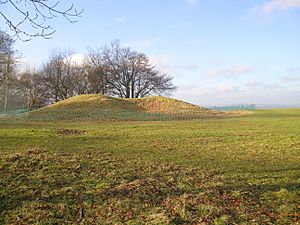Oval barrow facts for kids
An oval barrow is what archaeologists call a special type of ancient burial mound. Imagine a big, oval-shaped hill made of earth! These mounds were built a very long time ago, during prehistoric times.
In Britain, during the middle and late Stone Age (Neolithic period) and the early Bronze Age, oval barrows were important. They seem to show a change in how people buried their dead. Before these, there were longer mounds called long barrows that held many burials. After them came rounder mounds called round barrows, which often held just one person.
Sometimes, the people buried in an oval barrow might have been placed there many years before the mound itself was fully built. This makes it a bit tricky for archaeologists to understand all the burial traditions from that time.
Contents
Oval Barrows in England
Many examples of oval barrows have been found across England. Each one helps us learn more about the people who lived there thousands of years ago.
Buckinghamshire
Buckinghamshire is a county in England where some interesting oval barrows have been discovered.
Whiteleaf Hill Barrow
Near the top of Whiteleaf Hill in Buckinghamshire, there's a Neolithic oval barrow. It's located at a spot called SP 822040. Archaeologists have studied this mound many times.
The first excavations happened between 1934 and 1939. Later, from 2002 to 2006, more detailed digs took place. The mound isn't perfectly oval; it has a small dip on one side, making it look a bit like a kidney bean.
This barrow held only one burial. Scientists used a method called radio-carbon dating to find out when things happened. They learned that the person died, was buried, and the mound was built between 3,750 and 3,100 BC. However, these events didn't all happen at the exact same time within that period.
The remains of the person seemed to have been placed between two large wooden posts. These posts were about 1.2 meters apart. Archaeologists also found pieces of pottery and animal bones inside the mound. They think these might have come from special feasts held when the mound was being built.
Dorney Reach Barrow
Another oval barrow from the middle Neolithic period (around 3300–2800 BC) is at Dorney Reach. It's located on flat ground near the River Thames at SU 9170 7935.
For a long time, this barrow was only known from a "cropmark." This is a pattern in crops that shows where things are buried underground. Scientists used special tools like magnetometry and resistivity surveys to learn more without digging.
These surveys showed an oval ditch around the barrow, measuring about 20 by 12.5 meters. It runs from north-northeast to south-southwest. The surveys also hinted at two pits in the center. These pits might have been part of a wooden structure used for the burial, similar to what was found at Whiteleaf Hill.
Marsh Lane East (site 2)
Archaeologists believe this site was originally a Neolithic oval barrow. However, it was changed a lot during the Bronze Age. Because of these later changes, very little of the original oval barrow remains today.
Oxfordshire
- Abingdon
Kent
Yorkshire


